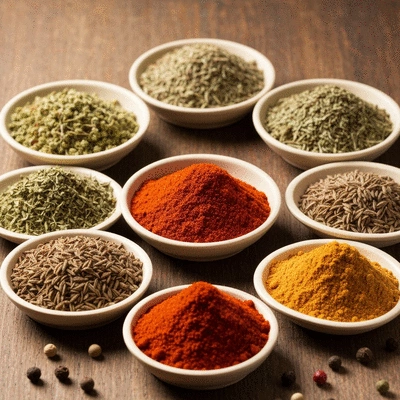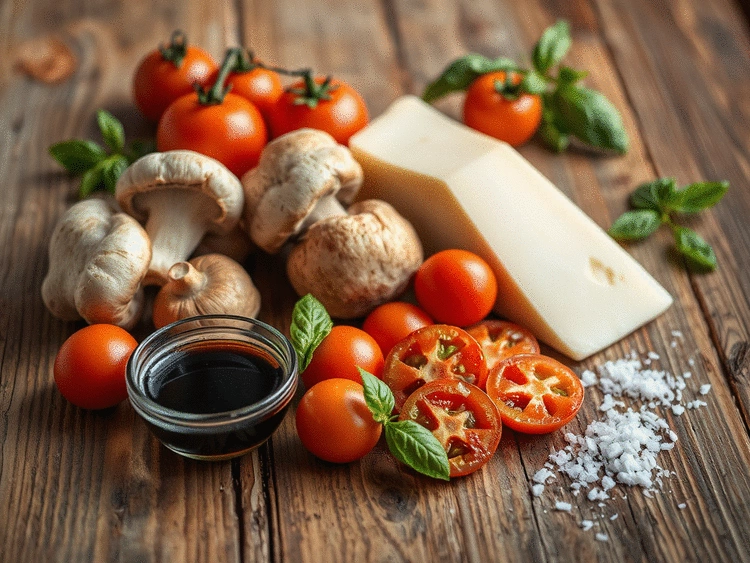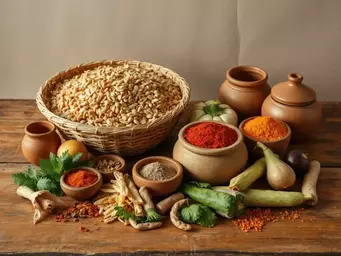Did you know that umami, often regarded as the fifth taste, can elevate your culinary experiences in ways you never imagined? This deep, savory flavor not only enhances the enjoyment of meals but also plays a pivotal role in the art of cooking. Let's dive into the essence of umami and discover how it can transform your dishes!
What You Will Learn
- Umami enhances the overall flavor profile of dishes, making them more satisfying and enjoyable.
- Glutamate, a key component of umami, is found in foods such as soy sauce, aged cheeses, and ripe tomatoes.
- Combining umami-rich ingredients can create complex layers of flavor that enhance your meals.
- Understanding taste receptors helps us appreciate how umami interacts with other flavors, providing a balanced taste experience.
- Cooking techniques like roasting and fermentation can increase glutamate levels, intensifying the savory notes in dishes.
- Inosinate and guanylate are compounds that, when paired with glutamate, further enhance umami flavors.
The Essence of Umami: A Flavor Breakdown
Delve into the science and synergy behind the fifth taste, exploring key components and their interactions.
Glutamate: The Core of Umami
- •**Flavor Enhancer:** Transforms dishes, adds depth.
- •**Natural Sources:** Tomatoes, mushrooms, aged cheeses.
- •**Cooking Techniques:** Roasting, fermentation increase levels.
Inosinate
Found in meats & fish. Boosts savory taste when combined with glutamate.
- •Meat & Fish
- •Glutamate Synergy
Guanylate
Found in mushrooms & seaweeds. Works with glutamate for enhanced flavors.
- •Mushrooms & Seaweeds
- •Flavor Intensifier
How We Experience Umami
- •**Receptor Activation:** Umami receptors respond to glutamate, causing satisfaction.
- •**Brain Response:** Pleasure signals enhance meal enjoyment.
- •**Flavor Integration:** Interacts with other tastes for a balanced profile.
Understanding Umami: The Fifth Taste and Its Scientific Basis
Have you ever taken a bite of a dish and found yourself captivated by its deep, savory flavor? That, dear readers, is the magic of umami, often referred to as the fifth taste. In this section, we’ll delve into what umami is, why it matters, and the fascinating science behind it. As a culinary enthusiast, I find that understanding umami can enrich our appreciation of food and transform our cooking experiences!
Umami, which translates to "pleasant savory taste" in Japanese, was identified as a distinct taste in the early 20th century. It plays a crucial role in our flavor perception and can enhance our enjoyment of meals. By embracing this taste, we can elevate our culinary creations, much like the vibrant dishes featured on my blog, Born Foodie.
What Is Umami and Why Is It Important?
Umami is not just a buzzword; it's a vital component of our taste experience. It is commonly associated with foods rich in glutamate, an amino acid that brings depth and complexity to flavors. Recognizing umami's importance can lead to a more delightful dining journey. Here’s why umami matters:
- Flavor Enhancement: Umami boosts the overall taste experience, making dishes more satisfying.
- Appetite Appeal: It can stimulate appetite and increase enjoyment, encouraging us to savor our meals.
- Culinary Versatility: Understanding umami allows cooks to pair ingredients in innovative ways, creating harmonious flavors.
As I explore culinary traditions, I see how various cultures harness umami to create memorable dishes. From the deep flavors of miso in Japanese cooking to the rich stocks in Italian cuisine, umami truly is a global experience!
The Role of Glutamate in Flavor Enhancement
Glutamate is at the heart of umami, acting as a flavor enhancer that can transform ordinary dishes into extraordinary ones. Found in foods like tomatoes, mushrooms, and aged cheeses, glutamate provides that savory kick we crave. The beautiful thing about glutamate is its ability to elevate flavors without overwhelming them.
- Natural Sources: Foods like soy sauce, parmesan cheese, and ripe tomatoes are packed with glutamate.
- Cooking Techniques: Methods such as roasting and fermentation increase glutamate levels, intensifying flavors.
- Umami-Rich Combinations: Pairing glutamate-rich foods with others can create a synergistic effect, enhancing overall taste.
By understanding glutamate's role, we can make informed choices in our cooking, fostering a deeper connection to our meals. Just like a well-crafted story, every dish has layers that can be uncovered, revealing the intricate flavors that speak to our hearts.

The Science Behind Taste Receptors: How We Experience Savory
Our taste buds are equipped with receptors specifically tuned to detect umami. When we consume foods high in glutamate, these receptors send signals to our brain, creating a sensation of satisfaction and fullness. Isn’t it fascinating how our bodies respond to flavors?
The science of taste receptors illustrates the complexity of flavor perception. Here’s a quick breakdown:
- Receptor Activation: Umami receptors respond to glutamate, leading to a heightened sense of savoriness.
- Brain Response: The activation of these receptors triggers pleasure signals in the brain, enhancing meal enjoyment.
- Integration with Other Tastes: Umami interacts with sweet, salty, sour, and bitter, creating a balanced flavor profile.
Understanding this science can empower us in the kitchen. By incorporating umami-rich ingredients, we can craft dishes that resonate personally and emotionally, just like the memories we cherish around the dining table.
Exploring Inosinate and Guanylate: The Synergistic Compounds
While glutamate is the star of the umami show, it’s not alone! Inosinate and guanylate are potent compounds that enhance umami flavors when combined with glutamate. These compounds are found in various foods and create a synergy that intensifies savoriness. For instance, the combination of dried fish and mushrooms can elevate a dish's umami profile.
- Inosinate: Commonly found in meats and fish, this compound boosts the savory taste, especially when paired with glutamate-rich ingredients.
- Guanylate: Found in mushrooms and certain seaweeds, guanylate works beautifully with glutamate to enhance flavors further.
- Synergistic Effects: When these compounds are combined, they create a richer, more complex flavor that enhances our eating experience.
As I dive deeper into the culinary worlds of different cultures, I find joy in discovering how these compounds interact, creating the beloved flavors we hold dear. Each ingredient has a story to tell, and as we explore umami together, let’s celebrate the connections that food fosters!
Pro Tip
To truly unlock the magic of umami, consider incorporating a splash of soy sauce or a sprinkle of parmesan cheese into your dishes. These ingredients not only enhance the savory notes but also create a depth of flavor that can transform a simple meal into a gourmet experience!
Summarizing the Science of Umami and Its Culinary Applications
As we dive into the world of umami, it’s essential to recognize how this fifth taste plays a pivotal role in our culinary experiences. Through the intricacies of glutamates and the synergy of various ingredients, umami is not merely a taste but a profound enhancer of flavors in our meals. Understanding these elements can transform the way we approach cooking and dining.
Here are some key takeaways regarding flavor enhancement through glutamates:
- Umami enriches the flavor profile of dishes, making them more satisfying.
- Glutamate, found in many natural foods, enhances savory flavors and can balance out sweetness and bitterness.
- Combining umami-rich ingredients can create layers of flavor that are both complex and irresistible.
As you explore the culinary landscape, consider how integrating umami can elevate your cooking. Have you ever experienced that delightful moment when a dish resonates with your taste buds? That’s the magic of umami at work!
Encouraging Exploration of Umami in Everyday Cooking
I invite you to embrace umami in your everyday meals. It’s about more than just taste; it's about creating memories and connections through food. When I think back to family gatherings, it’s those savory dishes that linger in my memory, evoking warmth and nostalgia.
Here are some practical tips for exploring umami in your cooking:
- Experiment with ingredients like mushrooms, tomatoes, and aged cheeses.
- Incorporate fermented items such as miso or kimchi to boost umami flavors.
- Utilize cooking techniques like roasting or grilling to enhance the savory notes in your dishes.
By intentionally seeking out umami-rich ingredients, you're not just cooking; you're crafting experiences! What new flavors are you excited to try?

The Influence of Food Chemistry on Taste Perception
Understanding the science behind our taste perception is vital in appreciating the depth of flavor that umami provides. The chemistry of food impacts how we perceive taste, and umami plays a transformative role in this process. It’s fascinating to consider how the combination of glutamates and other flavor compounds can create a symphony of tastes.
When we savor a dish, our taste buds and olfactory senses work together, enhancing our overall experience. This interaction highlights the emotional connection we have with food and the memories it evokes. Remember the last time a dish sent you on a nostalgic journey? That’s the essence of umami!
Next Steps for Flavor Enthusiasts and Home Cooks
Practical Actions to Enhance Your Cooking with Umami
Now that we've uncovered the layers of umami, it’s time to take action! Here are some straightforward steps you can implement in your kitchen:
- Incorporate umami ingredients into your favorite recipes—think soy sauce, miso paste, or sun-dried tomatoes.
- Try a new cooking technique that enhances flavor, like sautéing vegetables to draw out their natural sweetness.
- Combine complementary umami-rich foods to create exciting new dishes.
By integrating these practices, you’ll soon discover how umami can elevate your culinary creations to new heights!
Join the Conversation: Share Your Experiences with Umami
As we explore the richness of umami together, I’d love to hear your stories! What dishes have you encountered that perfectly captured this savory essence? Your experiences are invaluable to our community at Born Foodie. Please share your thoughts and recipes with us.
Experimenting with Flavor Pairings: Tips for Success
Finally, let’s talk about the exciting world of flavor pairings! Successful umami combinations can lead to delightful surprises. Here’s how to set yourself up for success:
- Start with a base ingredient that has natural umami, like roasted mushrooms or aged cheese.
- Complement with contrasting flavors, such as sweet or acidic components, to balance the dish.
- Keep an open mind—try unconventional pairings and let your taste buds guide you!
Remember, cooking is an adventure! Don’t be afraid to play with flavors and discover what resonates with you.
Frequently Asked Questions About Umami
What exactly is umami?
Umami is often described as the fifth basic taste, characterized by a savory, brothy, or meaty flavor. It's a fundamental taste alongside sweet, sour, salty, and bitter, and it enhances the palatability of foods.
What causes the umami taste?
The primary compound responsible for umami is glutamate, an amino acid naturally found in many foods. Other compounds like inosinate and guanylate can also create and enhance the umami sensation, especially when combined with glutamate.
Which common foods are rich in umami?
Many everyday ingredients are excellent sources of umami. These include ripe tomatoes, mushrooms (especially dried shiitake), aged cheeses (like Parmesan), soy sauce, miso, cured meats, and seaweed.
How can I incorporate more umami into my cooking?
To boost umami, try using ingredients like tomato paste, Parmesan rinds in soups, mushroom powder, or a dash of soy sauce or fish sauce. Cooking techniques such as roasting, grilling, and fermentation also concentrate umami flavors.
Does umami interact with other tastes?
Yes, umami is known to interact synergistically with other tastes. It can balance and round out flavors, making a dish more complex and satisfying. For example, umami can reduce perceived bitterness and enhance sweetness and saltiness.
Recap of Key Points
Here is a quick recap of the important points discussed in the article:
- Umami is the fifth taste, enhancing flavor and satisfaction in dishes.
- Glutamate, found in various foods, is key to experiencing umami and can elevate flavors.
- Inosinate and guanylate compounds work synergistically with glutamate to enrich flavor profiles.
- Understanding taste receptors helps us appreciate umami's role in flavor perception.
- Incorporating umami-rich ingredients into cooking can lead to memorable culinary experiences.






